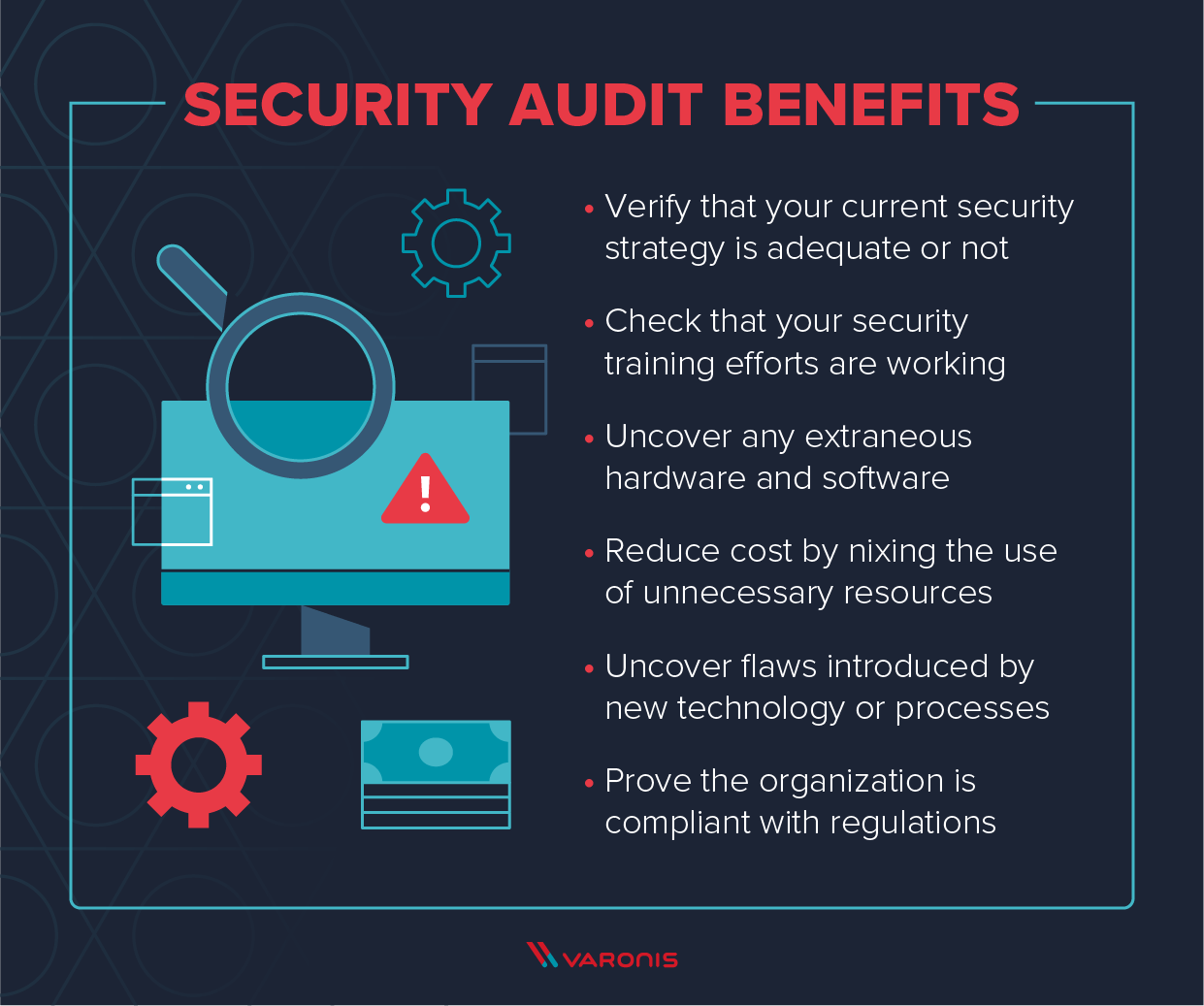How do you perform a security audit?
Summary of the Article
How do I prepare for a security audit?
Ways to Prepare for A Security AuditDetermine the reason for the audit.Notify internal and external stakeholders.Take inventory (hardware/software)Get the audit checklist before the audit.Review your policies.Perform a self-assessment.Preschedule tests or deliverables.
What is a security audit checklist?
An information security audit checklist is a list of security measures that must be taken to protect an organization’s information systems and data from various threats. This checklist aims to promote best practices of information security and guide how information should be managed, stored, and secured.
What does a security audit do?
Definition(s): Independent review and examination of a system’s records and activities to determine the adequacy of system controls, ensure compliance with established security policy and procedures, detect breaches in security services, and recommend any changes that are indicated for countermeasures.
How do you run an internal security audit?
Cybersecurity Audit ChecklistIdentify goals and assessment criteria.List potential threats.Assess staff training on digital security.Pinpoint risks in your virtual environment.Examine business practices against security policies.Evaluate data security strategy.Inspect active monitoring and testing approaches.
How to do audit for beginners?
Read on to learn more about making your first solo audit as productive and stress-free as possible:Step #1: Identify the scope and purpose.Step #2: Determine the documentation you need — and how to get it.Step #3: Learn your client’s financial workflow to create an audit trail.Step #4: Clearly communicate your results.
Which questions are assessed in a security audit?
Top 5 IT Security Audit QuestionsDo you have a documented security policyAre access privileges in your organisation granted adequatelyWhat methods do you use to protect your dataDo you have a disaster recovery planAre your employees familiar with existing security procedures and policies
What are the five audit checklist?
The five steps to manage an audit programme are:Establish the audit programme objectives.Prepare the audit plan.Perform the audit.Report the audit results.Follow up on post-audit activities.
What are the 3 types of audits?
There are three main types of audits: external audits, internal audits, and Internal Revenue Service (IRS) audits.
Who conducts a security audit?
Internal security audits: Internal security audits are conducted by an organization’s own security team or employees. These audits can either be event-based or routine. External security audits: External security audits are conducted by a third-party security firm or consultant.
What is the first step of security audits and reviews?
The first step of a network security audit is to define the scope and objectives of the audit. You need to determine what parts of the network you want to audit, such as servers, routers, firewalls, VPNs, endpoints, cloud services, etc.
What are the 7 steps in the audit process?
Preparing for an Audit. Have all requested materials/records ready when requested.

How do I prepare for a security audit
Ways to Prepare for A Security AuditDetermine the reason for the audit.Notify internal and external stakeholders.Take inventory (hardware/software)Get the audit checklist before the audit.Review your policies.Perform a self-assessment.Preschedule tests or deliverables.
Cached
What is a security audit checklist
An information security audit checklist is a list of security measures that must be taken to protect an organization's information systems and data from various threats. This checklist aims to promote best practices of information security and guide how information should be managed, stored, and secured.
Cached
What does a security audit do
Definition(s): Independent review and examination of a system's records and activities to determine the adequacy of system controls, ensure compliance with established security policy and procedures, detect breaches in security services, and recommend any changes that are indicated for countermeasures.
How do you run an internal security audit
Cybersecurity Audit ChecklistIdentify goals and assessment criteria.List potential threats.Assess staff training on digital security.Pinpoint risks in your virtual environment.Examine business practices against security policies.Evaluate data security strategy.Inspect active monitoring and testing approaches.
Cached
How to do audit for beginners
Read on to learn more about making your first solo audit as productive and stress-free as possible:Step #1: Identify the scope and purpose.Step #2: Determine the documentation you need — and how to get it.Step #3: Learn your client's financial workflow to create an audit trail.Step #4: Clearly communicate your results.
Which questions are assessed in a security audit
Top 5 IT Security Audit QuestionsDo you have a documented security policyAre access privileges in your organisation granted adequatelyWhat methods do you use to protect your dataDo you have a disaster recovery planAre your employees familiar with existing security procedures and policies
What are the five audit checklist
The five steps to manage an audit programme are:Establish the audit programme objectives.Prepare the audit plan.Perform the audit.Report the audit results.Follow up on post-audit activities.
What are the 3 types of audits
There are three main types of audits: external audits, internal audits, and Internal Revenue Service (IRS) audits.
Who conducts a security audit
Internal security audits: Internal security audits are conducted by an organization's own security team or employees. These audits can either be event-based or routine. External security audits: External security audits are conducted by a third-party security firm or consultant.
What is the first step of security audits and reviews
The first step of a network security audit is to define the scope and objectives of the audit. You need to determine what parts of the network you want to audit, such as servers, routers, firewalls, VPNs, endpoints, cloud services, etc.
What are the 7 steps in the audit process
Preparing for an Audit. Have all requested materials/records ready when requested.Step 1: Planning. The auditor will review prior audits in your area and professional literature.Step 2: Notification.Step 3: Opening Meeting.Step 4: Fieldwork.Step 5: Report Drafting.Step 6: Management Response.Step 7: Closing Meeting.
What is the first rule of auditing
1] Integrity, Independence and Objectivity
The auditor has to be honest while auditing, he cannot be favoring the organization. He must remain objective throughout the whole process, his integrity must not allow any malpractice. Another important principle is independence.
What are the three main audit findings
There are three different gradings for findings; Major non-conformance, minor non-conformance, and observation/opportunity for improvement.
What are sample questions during audit
Ask the External Auditors – General QuestionsDid the scope of the audit differ from the audit planWere you provided with all the information you requestedDid the organization or its counsel impose any limitations on youDid you observe any areas of serious concern over the corporate control environment
What are the 4 C’s of audit findings
Internal audit reports often outline the criteria, condition, cause, consequence, and corrective action.
What are the 4 C’s of internal audit
culture, competitiveness, compliance and cybersecurity
As for directors, there are four features to consider when evaluating the sufficiency of any risk-based audit plan: culture, competitiveness, compliance and cybersecurity – let's call them the Four C's, for short.
What are the 4 methods of auditing
The four types of audit reportsClean report. A clean report expresses an auditor's "unqualified opinion," which means the auditor did not find any issues with a company's financial records.Qualified report.Disclaimer report.Adverse opinion report.
What are the steps of auditing
Audit ProcessStep 1: Planning. The auditor will review prior audits in your area and professional literature.Step 2: Notification.Step 3: Opening Meeting.Step 4: Fieldwork.Step 5: Report Drafting.Step 6: Management Response.Step 7: Closing Meeting.Step 8: Final Audit Report Distribution.
How often should a security audit be performed
You should certainly conduct routine audits annually or semi-annually, and event-based audits should be done when any major events happen within your IT infrastructure. For example, suppose you add servers to your network or transition to a new project management software.
Are there any standards for performing security audits
The ISO/IEC 27000 family of standards are some of the most relevant to system administrators, as these standards focus on keeping information assets secure. The ISO/IEC 27001 is known for its information security management system requirements.
What is the step in audit procedure
Audit ProcessStep 1: Planning. The auditor will review prior audits in your area and professional literature.Step 2: Notification.Step 3: Opening Meeting.Step 4: Fieldwork.Step 5: Report Drafting.Step 6: Management Response.Step 7: Closing Meeting.Step 8: Final Audit Report Distribution.
What are the 4 basic principles of auditing
The basic principles of auditing are confidentiality, integrity, objectivity, independence, skills and competence, work performed by others, documentation, planning, audit evidence, accounting system and internal control, and audit reporting.
What are the 5 C’s of an audit finding
What Are the 5 C's of Internal Audit Internal audit reports often outline the criteria, condition, cause, consequence, and corrective action.
What are the 4 primary stages of an audit
Although every audit process is unique, the audit process is similar for most engagements and normally consists of four stages: Planning (sometimes called Survey or Preliminary Review), Fieldwork, Audit Report and Follow-up Review. Client involvement is critical at each stage of the audit process.
What is a leading question in an audit
Leading questions are survey questions that encourage or guide the respondent towards a desired answer. They are often framed in a particular way to elicit responses that confirm preconceived notions, and are favorable to the surveyor – even though this may ultimately sway or tamper with the survey data.



